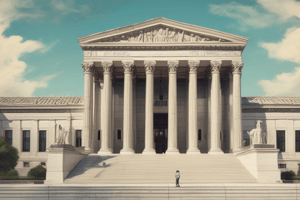Podcast
Questions and Answers
What is the primary responsibility of the United States Supreme Court?
What is the primary responsibility of the United States Supreme Court?
- To enact new laws
- To interpret state laws
- To hear cases involving federal laws (correct)
- To confirm presidential appointments
How many justices make up the United States Supreme Court?
How many justices make up the United States Supreme Court?
- Thirteen
- Eleven
- Seven
- Nine (correct)
Who appoints the Chief Justice of the United States Supreme Court?
Who appoints the Chief Justice of the United States Supreme Court?
- The President (correct)
- The Senate
- The judiciary committee
- The House of Representatives
Why are Supreme Court justices appointed for life terms?
Why are Supreme Court justices appointed for life terms?
What is the significance of the Chief Justice in the Supreme Court?
What is the significance of the Chief Justice in the Supreme Court?
When does the Supreme Court choose to hear a case based on its own discretion?
When does the Supreme Court choose to hear a case based on its own discretion?
What is a key aspect of the Supreme Court's independence mentioned in the text?
What is a key aspect of the Supreme Court's independence mentioned in the text?
How does the Supreme Court's unique role in the process of impeachment protect its independence?
How does the Supreme Court's unique role in the process of impeachment protect its independence?
Which case established the principle of judicial review for the Supreme Court?
Which case established the principle of judicial review for the Supreme Court?
How does the separation of powers help maintain the independence of the judiciary?
How does the separation of powers help maintain the independence of the judiciary?
Why is the Supreme Court considered a guardian of the Constitution?
Why is the Supreme Court considered a guardian of the Constitution?
How does the Supreme Court's independence contribute to American democracy?
How does the Supreme Court's independence contribute to American democracy?
Flashcards are hidden until you start studying
Study Notes
The Supreme Court of the United States: Structure and Independence
The United States Supreme Court (SCOTUS) is a foundational institution of our federal government, playing a crucial role in shaping the nation's legal landscape. To understand the Supreme Court's importance, we must delve into the court's structure and the independence it enjoys from the control of the executive and legislative branches.
The Court's Structure
The Supreme Court is the highest judicial body in the country. It consists of nine justices, appointed by the President and confirmed by the Senate for life terms. This lifelong appointment is aimed at ensuring the justices' independence and impartiality.
The Chief Justice, who presides over the court, is designated by the President and confirmed by the Senate. Currently, Chief Justice John Roberts holds this prestigious position. The other eight justices are numbered according to the order of their confirmation.
The Court's Jurisdiction
The Supreme Court's primary responsibility is to hear cases involving constitutional issues, federal laws, and disputes between states. Cases are often appealed from lower federal courts and the highest courts in individual states. In certain circumstances, the court can also choose to hear cases based on its own discretion through the process of certiorari.
The Court's Independence from the Executive and Legislative Branches
The Constitution provides for the Supreme Court's independence to ensure an impartial and non-political judicial system. The court's life tenure for justices is a key aspect of this independence. The justices are not accountable to the President or Congress for their decisions, allowing them to make judgments based on the law and the Constitution.
The court's independence is further protected by its unique role in the process of impeachment. If a justice is impeached, they are tried in the Senate. However, no conviction can occur without the approval of two-thirds of senators present, meaning that impeachment does not serve as a mechanism for removing a justice from the court.
The Court's Role in Separation of Powers
The judiciary, along with the executive and legislative branches, forms the three main branches of government. The separation of powers ensures that each branch has safeguards against the encroachment of the others. The Supreme Court plays a critical role in this separation by reviewing the actions of the President and Congress to ensure that they do not overstep their constitutional powers.
The court's authority in this realm has expanded over time. For instance, in Marbury v. Madison (1803), the court established the principle of judicial review, asserting its power to strike down a law as unconstitutional. This decision continues to be a cornerstone of the court's influence in American government.
Final Thoughts
The Supreme Court serves as a guardian of the Constitution and an arbiter of federal law. Its independence from the control of the executive and legislative branches ensures the impartiality of the court and the integrity of the judicial system. This independence, although not guaranteed in every nation, is a key component of American democracy. The court's structure, jurisdiction, and role in the separation of powers emphasize its unique position in American government and society.
Studying That Suits You
Use AI to generate personalized quizzes and flashcards to suit your learning preferences.




